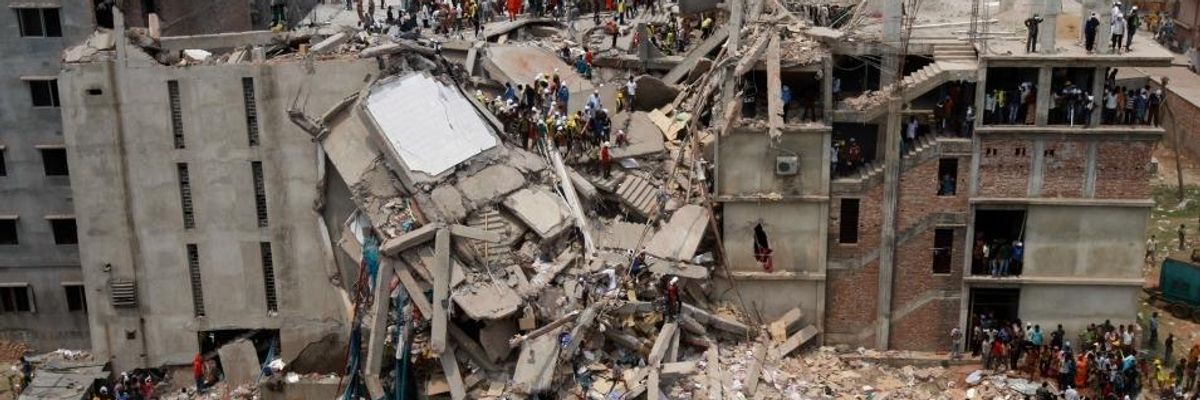Global fashion brands dictate the precise designs of clothes down to the last stitch, yet claim to have little power to ensure the basic rights of workers in factories. On the third anniversary of the Rana Plaza factory collapse, the voices of garment workers continue to be ignored.
The mass of rubble and clothes. Stunned workers emerging on makeshift stretchers. Then the news: it wasn't an accident. Factory workers had seen the cracks. Rana Plaza had been evacuated, but garment workers were forced to return, for fear of losing their jobs.
Three years after the devastating collapse of Rana Plaza in Bangladesh, the factory owner is in prison, compensation to victims and families has been paid and global garment brands continue to profit from exploitation of workers in Bangladesh.
Over 1100 workers were killed and thousands more seriously injured on 24 April 2013, yet it took years for brands to pay compensation to victims.
Three years on, workers are still forced to work 14-16 hours a day, six days a week, face routine abuse in the workplace, and all for poverty wages that aren't enough to pay rent in a slum or provide three meals a day.
All over the world, fashion brands are driven by the search for lowest production prices and the highest profit.
The race to the bottom on wages and competition across garment producing countries has left local factories scrambling to offer the cheapest production prices at the expense of the rights of workers. Exploitation of workers is the norm, and relied upon to rake in profits for the brands.
But we cannot say that nothing has changed.
The Bangladesh Safety Accord marked the first step towards holding garment companies to account for the working conditions in their supply chains, and now it is no longer contested that the brands are responsible for the human rights abuses that workers face.
It is finally accepted that the issues driving the exploitation of workers and their unsafe working conditions cannot be tackled on a case-by-case basis. The system is at fault and stacked in favour of the brands: profits come before people.
This February, another fire broke out in a garment factory in Bangladesh. Had the fire broken out an hour later, 6000 workers would have been crammed into the building making clothes for the UK high street.
The factory had been inspected by the Bangladesh Accord years earlier, but changes had not been made. Whether the thousands of factory inspections will lead to safer workplaces remains to be seen.
Perhaps the biggest change since the factory collapse, has been in the awareness of garment workers themselves.
The unprecedented international attention on working conditions brought about by the Rana Plaza collapse flicked a switched in the minds of many workers, previously resigned to the grim reality of life working in a sweatshop.
The shift among workers was such that many workers now refer to working life as 'before Rana Plaza, and after Rana Plaza.'
Workers and unions recognise that the best tool to create decent working conditions is their right to organise and collectively bargain in factories. While this is a basic human right, workers who form unions and attempt to negotiate together still face severe intimidation and violence, alongside the ever-present risk of losing their job. Their voices are all too often marginalised or dismissed.
Yet despite this, garment workers, mostly women, are far from hapless victims; they continue to fight every day to improve working conditions for themselves and each other. They also have a clear analysis of the problem: international brands are responsible for their exploitation, it is they who benefit from it.
The success of workers' initiatives in improving their wages, hours and factory conditions has been mirrored by a corresponding failure of the international community to implement binding, enforceable legislation to ensure that a living wage and safe working conditions are mandatory in garment factories, everywhere.
Voluntary regulation has failed; voluntary standards have enabled brands to present themselves as ethical without having to change a thing about how they operate. National regulation, alongside legally binding international mechanisms is long overdue.
The opportunity exists in the form of a UN treaty that is currently being negotiated, to form a set of laws to hold corporations to account at an international level for their impact on human rights. This could also provide a well-resourced tool to monitor and enforce these standards and provide an instrument to penalize the failure of corporations to ensure these basic rights.
This could mean that no matter where the clothes are being made, workers will be guaranteed a living wage, safe working conditions, regular working hours and the right to join a union.
We know corporations will do all they can to avoid this and protect their profits, so the voice of garment workers must be even louder if we are to pressure our government to support this process.
Brands dictate the precise designs of clothes down to the last stitch, yet claim to have little power to ensure the basic rights of workers in factories. The reality is, that if the rights of workers were put first, they could ensure human rights across their supply chain.
A garment industry that provides justice and dignity for garment workers is possible. The UK Government already tried to sink plans for a binding treaty. It now must support the international process to hold corporations to account for human rights abuses.
If it doesn't, we will have once again failed the people who make our clothes.


